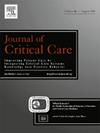Evaluating extreme temperature values and patient outcomes in aneurysmal subarachnoid hemorrhage: Post-hoc insights from the Earlydrain trial
IF 2.9
3区 医学
Q2 CRITICAL CARE MEDICINE
引用次数: 0
Abstract
Purpose
Dysregulation of temperature in aneurysmal subarachnoid hemorrhage (aSAH) patients may worsen neurological outcomes. Fever and hypothermia could be related to infection, inflammation, or loss of central temperature control. However, longitudinal studies on temperature extremes and outcomes are lacking. This post-hoc analysis of the Earlydrain trial examines the prognostic significance of body temperature during the first 8 days of neurocritical care.
Methods
We analyzed data from 287 patients, using Generalized Estimating Equations to investigate clinically used thresholds for intervention on body temperature. Statistical models were adjusted for hemorrhage severity, age, intracerebral and intraventricular hemorrhage, infection and the use of a lumbar drainage. We assessed the impact of different temperature thresholds on the modified Rankin Scale (mRS) at 180 days and the incidence of secondary infarctions.
Results
Extreme temperatures were associated with worse 180-day outcomes. In univariate analysis, all investigated temperature thresholds (>38.0 °C, >38.2 °C, > 39.0 °C, as well as <36.0 °C) were associated with worse outcome. In multivariate analysis, temperatures above 39 °C and below 36 °C increased the odds of an unfavorable mRS >2 (ORadj = 2.60, p = 0.002 and ORadj = 3.82, p = 0.02, respectively). The development of secondary infarctions was not significantly related to temperature extremes.
Conclusion
Extreme temperature values significantly influence outcomes in aSAH. Maintaining normothermia may improve prognosis, warranting prospective studies for targeted temperature management.
评估动脉瘤性蛛网膜下腔出血的极端温度值和患者预后:来自Earlydrain试验的事后观察
目的动脉瘤性蛛网膜下腔出血(aSAH)患者的体温失调可能使神经系统预后恶化。发热和体温过低可能与感染、炎症或中心体温控制丧失有关。然而,缺乏对极端温度和结果的纵向研究。这项对Earlydrain试验的事后分析检验了在神经危重症护理的前8天体温的预后意义。方法对287例患者的数据进行分析,应用广义估计方程探讨临床使用的体温干预阈值。统计模型根据出血严重程度、年龄、脑内出血和脑室内出血、感染和腰椎引流的使用进行调整。我们评估了不同温度阈值对180天改良Rankin量表(mRS)和继发梗死发生率的影响。结果高温与180天的不良预后相关。在单变量分析中,所有调查的温度阈值(>38.0°C, >38.2°C, >;39.0°C和36.0°C)的患者预后较差。在多变量分析中,高于39°C和低于36°C的温度增加了不良mRS的几率[gt;2] (ORadj = 2.60, p = 0.002和ORadj = 3.82, p = 0.02)。继发性梗死的发生与极端温度无显著相关性。结论极端温度值对aSAH的预后有显著影响。维持体温正常可能改善预后,因此有必要对目标温度管理进行前瞻性研究。
本文章由计算机程序翻译,如有差异,请以英文原文为准。
求助全文
约1分钟内获得全文
求助全文
来源期刊

Journal of critical care
医学-危重病医学
CiteScore
8.60
自引率
2.70%
发文量
237
审稿时长
23 days
期刊介绍:
The Journal of Critical Care, the official publication of the World Federation of Societies of Intensive and Critical Care Medicine (WFSICCM), is a leading international, peer-reviewed journal providing original research, review articles, tutorials, and invited articles for physicians and allied health professionals involved in treating the critically ill. The Journal aims to improve patient care by furthering understanding of health systems research and its integration into clinical practice.
The Journal will include articles which discuss:
All aspects of health services research in critical care
System based practice in anesthesiology, perioperative and critical care medicine
The interface between anesthesiology, critical care medicine and pain
Integrating intraoperative management in preparation for postoperative critical care management and recovery
Optimizing patient management, i.e., exploring the interface between evidence-based principles or clinical insight into management and care of complex patients
The team approach in the OR and ICU
System-based research
Medical ethics
Technology in medicine
Seminars discussing current, state of the art, and sometimes controversial topics in anesthesiology, critical care medicine, and professional education
Residency Education.
 求助内容:
求助内容: 应助结果提醒方式:
应助结果提醒方式:


